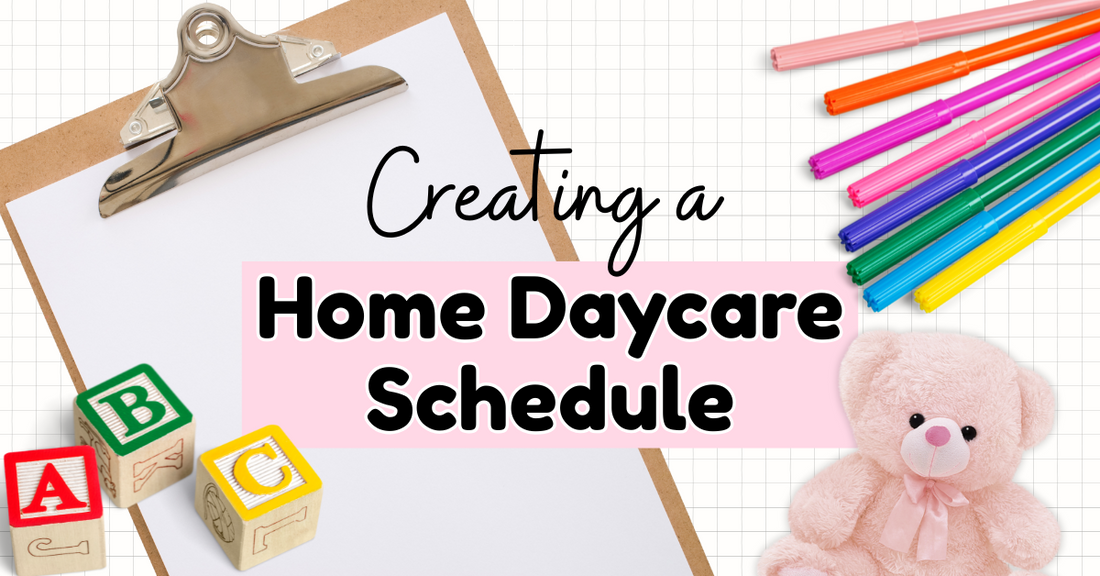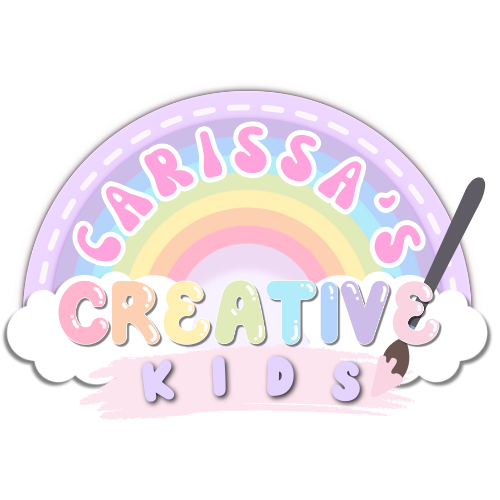
Creating a Home Daycare Schedule That Actually Works (For You and the Kids)
Running a home daycare means wearing a dozen hats before lunch—comforter of tears, snack time strategist, imagination guide, and steady hand in the storm. And if you’re anything like me when I first started, you probably heard a lot about the importance of structure... but weren’t quite sure what that actually looked like in a cozy home setting.
After more than a decade of running a home daycare, I can tell you: having a consistent home daycare schedule is one of the best things I ever did for myself and the children in my care.
But it didn’t start off perfectly. It evolved, it adapted, and I learned (sometimes the hard way) what actually worked. So let’s talk about how to build a home daycare schedule that fits your rhythm, helps your kids thrive, and leaves room for flexibility—because we all know teething babies, toddler negotiations, and mornings without coffee don’t follow a schedule.
Why a Consistent Schedule Matters in Home Daycare
One thing I learned early on: kids crave predictability. A daily rhythm helps them feel safe and secure. When they know what comes next, they feel more in control—and fewer meltdowns tend to follow.
But it’s not just about the kids. A consistent schedule gives you, the provider, a sense of flow. You’re not constantly reinventing the wheel. You’re not battling chaos all day. Everyone moves through the day with a steady rhythm.
And the hidden gem? Transitions. Having a set schedule gives children the chance to practice moving from one activity to another—a skill so many little ones struggle with. But when transitions happen every day, at the same times, they become less jarring and more manageable. Pairing the schedule with simple strategies—like giving a few minutes’ warning before a transition—it becomes even more effective
How My Daycare Schedule Evolved Over Time
When I first opened my daycare, I started with a written schedule that I hung on the wall. It was colorful, cute... and completely useless. My kids were all under five and couldn’t read a word of it. I quickly realized that if I wanted them to truly understand the rhythm of our day, I needed a visual schedule.

This was my very first daycare schedule—adorable, but completely impractical. My group was all under five, so none of them could read it. That’s when I realized I needed a visual schedule they could actually use.
I swapped the text for photos of each activity. A picture of kids putting on boots meant outdoor time. A snack symbol meant food was on the way. It clicked. The kids began pointing to the next part of the day, feeling empowered by the predictability.
Visual schedules became such a game-changer for us that I now make my own sets available for other providers. If you’d like to skip the trial-and-error I went through, you can grab my Printable Daily Schedule Cards. They’re editable, picture-based, and designed for infants through preschoolers—so even the littlest ones can “read” the flow of the day.

Another big shift came with seasonal changes. I live in Alberta, where winters can drop to -40°C. My schedule always includes plenty of outdoor play, but in the dead of winter? We pivot. My backyard felt like an extension of our playroom in the warmer months, but when it was just too cold, we got creative indoors.
Instead of freezing our fingers off, we:
- Built obstacle courses inside with cushions and tunnels
- Turned the Nugget couch into a fort
- Brought snow inside in bins for sensory play—kids would build little snowmen, then paint them with colored water and brushes
- Had dance parties with disco lights

The key was keeping the spirit of the schedule—movement, sensory play, creativity—even if the activity itself changed.
And while screen time isn’t part of our regular routine, we did have one special tradition: Friday Movie Day. Every Friday afternoon, we’d go upstairs into the living room (a space the daycare kids didn’t usually play in), snuggle up with blankets, and watch a movie together. We always made it extra fun with themed snacks and drinks, and it became one of the highlights of our week. Because TV wasn’t a normal part of our schedule, this weekly ritual felt exciting and truly special.
Our Actual Daily Home Daycare Schedule
Here’s what our rhythm looked like:
7:30–8:30 AM – Arrival & Free Play
Unstructured time for arrivals, open-ended toys, and connecting with friends.
8:30–9:00 AM – Morning Snack
A healthy snack to fuel the morning, plus a chance to practice table manners and conversation.
9:00–10:30 AM – Outdoor Play
Fresh air and gross motor play in the yard, on walks, or through nature-based adventures.
10:30 AM–12:00 PM – Circle Time & Learning Activities
We started with a short 10–15 minute circle time where we played group games, read a story, and sang songs related to our weekly theme. Then we transitioned into play-based learning with themed activities, crafts, and sensory bins—focused learning through hands-on fun.
12:00–12:30 PM – Lunch
Nutritious, balanced meals with a focus on self-help skills and independence.
12:30–2:00 PM – Nap/Rest Time
Quiet time to recharge. Even non-nappers could look at books, listen to soft music, or do calming activities.
2:30–3:00 PM – Afternoon Snack
Another healthy snack, time to regroup, take care of diaper changes and potty breaks, and ease into the afternoon.
3:00–4:00 PM – Creative Play & Outdoor Time
More outdoor play (weather permitting), or open-ended art and dramatic play indoors.
4:00–5:00 PM – Group Reflection & Departure
We gathered for a simple reflection and chat—talking about what was coming up tomorrow, our favorite parts of the day, or revisiting lessons. Sometimes we’d read a story, then move into our clean-up routine and prepare for pickups. Most afternoons, we’d head outside with backpacks and crafts, and the kids would play while I filled out daily sheets to send home.
Flexibility is Part of the Lesson
There was a time when I felt discouraged if the schedule didn’t go exactly as planned. But over the years, I’ve come to see those moments for what they really are: teachable opportunities.
Sometimes the baby won’t nap. Sometimes a child arrives late and the morning flow gets thrown. Sometimes I forget my second cup of coffee and we all need a reset. (We’ve all been there.)
But here’s the truth: being flexible models resilience. Kids learn how to pivot when things change. They see adults adapt with grace (most days, anyway). That’s just as valuable as circle time.
10 Tips for Creating Your Own Home Daycare Schedule
1. Observe your group
Notice when the children are naturally energetic vs. when they crash. Build your schedule around those rhythms instead of fighting against them.
2. Use visuals
Especially for toddlers and preschoolers, pictures speak louder than words. Visual schedules help even the youngest children know what’s coming next.
3. Keep it posted
Hang your schedule at the children’s eye level so they can reference it throughout the day. This builds independence and reduces constant “what’s next?” questions.
4. Plan for transitions
Add buffer time between activities to reduce stress. A five-minute warning or a simple routine (like putting on music) can make moving to the next activity smoother.
5. Revisit seasonally
Weather, daylight, and age group dynamics change—and so should your schedule. What works in summer may not fit in the middle of winter.
6. Forgive the off days
Life happens. Kids learn just as much from how we handle those unpredictable moments as they do from circle time.
7. Use songs and cues
Simple, predictable songs can make transitions fun. In my daycare, we sang “It’s time to clean up, it’s time to clean up, everybody lend a hand, it’s time to clean up” to the tune of Old MacDonald. The kids loved it, and cleanup time was smoother because they knew the song meant action.
8. Balance active and calm
Alternate between high-energy play (like outdoor time) and quieter activities (like storytime or crafts). This keeps kids regulated and helps prevent meltdowns.
9. Plan for yourself, too
Use nap time wisely—it can be a chance to prep meals, plan crafts, tidy up, or write newsletters. And sometimes, it’s just as important to sit down, scroll Pinterest, and recharge with a cup of coffee. Balance matters for providers, too.
10. Involve the kids
Give children ownership in the schedule. Let them flip the cards, sing the transition songs, or choose between two activities. The more engaged they feel, the smoother your days will run.
A Consistent Schedule Can Change Everything
Creating a daily rhythm in your home daycare makes life smoother for you and the children in your care. If you’d like ready-to-go, editable visual schedule cards designed for infants through preschoolers, you can find the same ones I use in my daycare. They’ve been a true game-changer in helping kids understand and feel empowered by our routine.
Your daycare schedule can be both structured and flexible—giving children the security they need while giving you the freedom to adapt when life happens. That balance is where the magic really happens.
You’ve got this.
-Carissa

